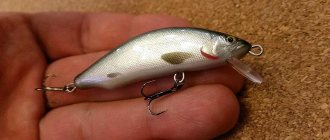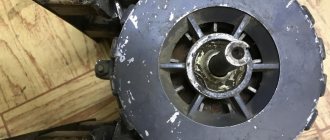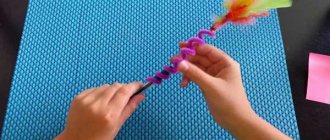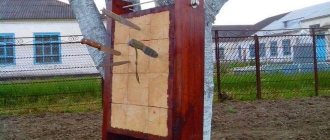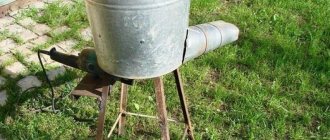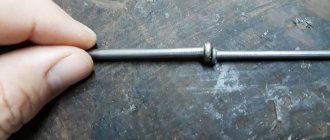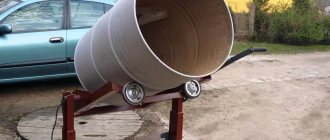A person should always engage in physical activities, whether in childhood or adulthood. Martial arts, which are suitable for both men and women, can be good sports. To train in disciplines such as boxing or kickboxing, you do not need to attend special classes. Of course, nothing can replace a good trainer, but you can equip yourself with all the necessary equipment.
The most important question for beginning boxers is how to make a boxing bag, and will it be much worse than a store-bought one?
What is a pear made of?
The pear is made of two parts: a filler and a container into which this filler is poured. The bag acts as a container (see photo).
To make a bag use:
- very dense fabric;
- tarpaulin;
- artificial or natural leather.
Several materials act as filler:
- fine crushed stone;
- sand;
- sawdust.
Fastening
For fastening you will need 8 stitched strips of fabric, about 40 centimeters long and 15 centimeters wide. We fold the strips three times so that the width is 5 centimeters and stitch them. Now we sew them to the neck of the bag so that they form “ears” into which a steel ring will be threaded for fastening. Moreover, the ring must be inserted in advance, before we start sewing on the “ears”.
How to make pear at home?
Now that you have decided on the material, you can begin the preparatory work. You will need three bags and appropriate fillers. The bags are sewn from the fabric that was chosen for the pear. The most preferable is leather, since dense fabric will soon begin to lose sand, and the tarpaulin itself is very hard - it will be impossible to approach it without gloves. And exercises for the legs will simply be impossible, since the legs will get tired quickly.
Each bag should be 1-2 cm larger than the previous one. It is not recommended to sew a pear from a bag used for sugar or flour, because... they most likely will not withstand even three training sessions and will break through.
The seams are made with nylon thread, each row is stitched three times. Glue is applied over the thread seam, which is used to fasten the rubber surfaces. Some people make a pear simply from sand, and as a short-term option it is quite acceptable.
Take the smallest bag and fill it with crushed stone. Then it is inserted into a larger bag. The distance between the outer side of one and the inner surface of the other is filled with sand. After this, the third bag is pulled, and the layer between the surfaces must be filled with sawdust. It should also be taken into account that after the first training, the third layer will settle a little, and it will be necessary to supplement it with sawdust, so the filling paths should open easily.
Features of the device
A punching bag differs from a training bag in its elongated dimensions and greater weight. For gyms, exercise equipment weighing 30–35 kg is usually used. This device is designed for practicing punches, kicks, and combined effects.
The cylindrical punching bag is designed for maximum impact on the part of the athlete. Products are divided into three weight categories: light, medium and heavy. Their weight ranges from 55 to 115 kg. The most commonly used filler for a punching bag or punching bag in the form of a large cylinder is sawdust with sand; polymer or rubber crumbs are also used. The outer part of the device is made of tarpaulin, leatherette, and genuine leather.
The water filling bag is mounted on the floor and consists of several elements. Its features:
- The upper part is made in the form of a human frame or a standard punching bag.
- The base is made springy, but reliable, not moving to the sides due to the weight of the product.
- The stability of the simulator is achieved by filling the lower compartment with liquid or sand.
Finding a boxing bag will not be a problem. It is considered one of the safest and most convenient devices for home training. The table shows other modifications of punching bags, among which everyone can choose the appropriate option.
| Variety | Description |
| Cone bag | Purpose - improvement of side, direct and combined blows to the head. Trajectory - along the lower cylinder and upper conical surface |
| Skittles | The punching bag is applicable for various types of martial arts, used for practicing kicks (all parts), punches, and all kinds of complexes |
| Uppercut design | The product is used to improve low blows (uppercuts). The structure weighs 30–55 kg and is suspended parallel to the floor level. Shell - leatherette or genuine leather |
| Drop-shaped version | A punching bag is filled with padding or air. The device is used to hone the speed of strikes with instant reactions and evasions. The design is hinged, located between elastic clamps |
| On stretch marks | The model is attached to guy wires, swings after the impact, and quickly returns to its original position. Filling - air or special padding |
| Pneumatic speed model | Model with internal pneumatic cylinder. The punching bag is fixed on a special platform and is designed to train reactions, a certain rhythm, and endurance. |
| Wall pillow | A separate category, equipped with a wooden frame for mounting to the wall. Stuffed with felt and foam rubber with a thickness of at least 50 mm. Designed to hone the rigidity and power of impacts |
A homemade punching bag is preferred by amateurs and professionals who do not have the time to visit the gym or financial resources. A correctly made unit is practically in no way inferior to factory analogues. Homemade simulators have several modifications designed for children and adult users; Universal versions are also produced.
Uppercut
teardrop-shaped
Skittles
Cone
On stretch marks
Wall pillow
Pneumatic
Fasteners for punching bag
There are several options to create a reliable fastener for the pear:
- use eyelets and carabiners used by climbers; you will have to tinker with inserting the eyelets a lot, although in the end the pear will turn out to be quite decent;
- cut a circle out of thick plywood, drill holes in it for the rope, stretch the rope, securing it with knots on the back side; the circle will have to be covered with leather and firmly sewn into the pear.
There are no difficulties in how to make a pear at home. Except for the hard work with the fabric, which is very dense. It will be possible to work with it only with the help of special tools.
The dimensions of such a homemade pear can vary, and with high-quality processing of the fabric, you can make these for friends or even the gym. The very first training sessions will help you evaluate your work not only visually, but also through direct contact.
About the softening shell
Such a shell is isolon, or PPE. They can be bought at construction stores. Suitable density: 8 -10 mm.
Softening shell functions:
- Makes the apparatus more comfortable for training.
- Perfectly distributes the attack throughout the filler.
- Reduced shrinkage.
- The projectile holds evenly when stuffed, making it easier to fill.
Also, thanks to this shell, there are no folds or wrinkles on the bag.
The softening product can be purchased by the cut. Buy a piece that matches the height of your bag and the length of its circumference.
Today, almost all branded bags are equipped with a softening shell.
Sawdust
Another option for stuffing a punching bag is sawdust and tyrsa. There are those who claim that if you mix these elements, you will get a capable projectile. But let's be realistic - this is not the best option.
First of all, the sawdust cakes. Moreover, they are susceptible to fungal influence. The sawdust itself is quite light, so the projectile will be quite weightless, which will suit a very small number of athletes.
It is worth adding to this that over time, the upper part of the bag will become light and soft, and the lower part will harden. Plus, this type of bag is considered the loudest and dustiest. Otherwise, the decision remains up to those who decide to fill their punching bag themselves.
I managed to find a solution that is better than crumb rubber for large bags!
This is a truly innovative solution.
Material advantage:
- The total weight of the bag is 30% lighter than that filled with rubber of the same volume. reduction of freight transportation costs for the manufacturer and the end consumer.
- In the video, we changed the hardness of the pear by removing the rubber and adding granules. A hard pear can be made softer.
- The granules do not stick together and, accordingly, the rigidity does not increase over the entire surface of the bag. Tested for 300 kg. bags.
- It is an order of magnitude more convenient to transport and fill the projectile.
- The granules do not stain your hands, do not smell and are absolutely harmless
- Moisture resistant material. Can be used outdoors if you use moisture-resistant material for the shell
Cost per kg - 57 rubles . This is slightly more than the cost of rubber, but significantly less than the cost of horsehair. An almost eternal 100 kg bag will cost you 5,700 rubles . + shell cost. Just compare prices for pears on the Internet! Prices 2022...
At the same time, for bags up to 50 kg, I suggest you continue to use crumb rubber. Only pure crumbs without impurities. If you have problems with tires, we also make them in Voronezh. Ready to refurbish your gym?
Or are you our manufacturer and ready to produce shells that people really need?
Leather scraps and rags
Such materials are the best stuff to stuff punching bags with. The leather scraps are soft enough, but at the same time hard, so as not to injure your hands and provide shock absorption.
Over time, the leather does not break down or rot. It is believed that pears stuffed with pieces of leather are the most durable. It is best if they are mixed with cotton rags.
As for rags, they can also be used in their pure form. For this, pieces of fabric of both natural and synthetic types are used. The material is quite heavy and flexible. Even after active work with the projectile, after some time it returns to its form on its own.
So what to choose?..
In fact, the question of which filler is best for a punching bag can hardly have a clear answer. Obviously, you should not choose options with sand, sawdust or tyrsa. Models with rubber shavings or leather flaps are considered the most versatile. Also in recent years, expanded clay and polyethylene balls have gained particular popularity; they are durable and have excellent mechanical properties.
Pneumatic and hydraulic bulbs are popular and practical, but specific options that are optimal in certain situations and can hardly be recommended for beginners. But what can be recommended and even necessary is our specialized catalog https://tut-boxing.ru/trenirovochnoe-snarjazhenie/bokserskie-grushi/. Here are the most popular models of different types and sizes from the world's leading brands (Green Hill, RDX, TWINS, etc.). In addition, you can always contact us, and our specialists will definitely give you professional recommendations on choosing the best pear for your specific situation.
Polyethylene foam (PPE)
One of the important properties of a sports bag for high-quality impact training is maintaining its shape under load. Changing the geometry of the projectile leads to a deterioration in the characteristics of subsequent impacts, which is unacceptable during training. To maintain its shape, experts recommend using polyethylene foam inserts with a thickness of 8-12 mm. When striking, such an insert increases the contact patch, making it more “natural”. Tactility improves, making training more comfortable. With their help, the rebound of the punching bag (bag) is adjusted.
